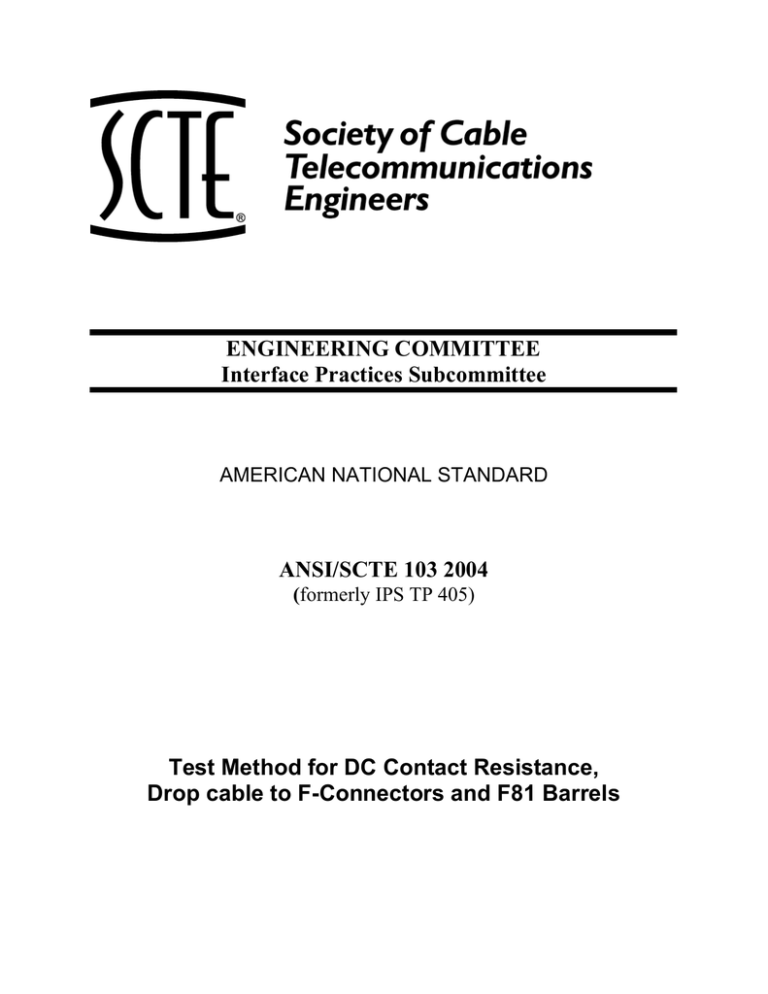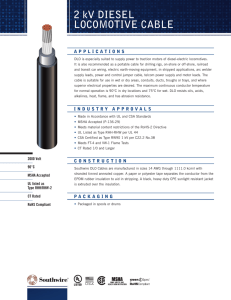
ENGINEERING COMMITTEE
Interface Practices Subcommittee
AMERICAN NATIONAL STANDARD
ANSI/SCTE 103 2004
(formerly IPS TP 405)
Test Method for DC Contact Resistance,
Drop cable to F-Connectors and F81 Barrels
NOTICE
The Society of Cable Telecommunications Engineers (SCTE) Standards are intended to serve the
public interest by providing specifications, test methods and procedures that promote uniformity
of product, interchangeability and ultimately the long term reliability of broadband
communications facilities. These documents shall not in any way preclude any member or nonmember of SCTE from manufacturing or selling products not conforming to such documents, nor
shall the existence of such standards preclude their voluntary use by those other than SCTE
members, whether used domestically or internationally.
SCTE assumes no obligations or liability whatsoever to any party who may adopt the Standards.
Such adopting party assumes all risks associated with adoption of these Standards, and accepts
full responsibility for any damage and/or claims arising from the adoption of such Standards.
Attention is called to the possibility that implementation of this standard may require the use of
subject matter covered by patent rights. By publication of this standard, no position is taken with
respect to the existence or validity of any patent rights in connection therewith. SCTE shall not
be responsible for identifying patents for which a license may be required or for conducting
inquiries into the legal validity or scope of those patents that are brought to its attention.
Patent holders who believe that they hold patents which are essential to the implementation of
this standard have been requested to provide information about those patents and any related
licensing terms and conditions. Any such declarations made before or after publication of this
document are available on the SCTE web site at http://www.scte.org.
All Rights Reserved
© Society of Cable Telecommunications Engineers, Inc.
140 Philips Road
Exton, PA 19341
i
TABLE OF CONTENTS
1.0
SCOPE .........................................................................................................2
2.0
TEST SAMPLES .........................................................................................2
3.0
EQUIPMENT ..............................................................................................3
4.0
PROCEDURE..............................................................................................3
5.0
TEST RESULTS..........................................................................................5
6.0
DISCUSSION ..............................................................................................5
1
1.0
SCOPE
1.1
2.0
The purpose of this test procedure is to measure the contact resistance or intimacy
of contact between an F connector and the drop cable shield (outer conductor
contact resistance) or the cable center conductor and the F81 barrel (inner
conductor contact resistance.). This method is used to evaluate the tendency for
unwanted high-resistance contacts. Depending on the application, high resistance
contacts may cause excessive energy losses, overheating and possibly, in Cable
Telecommunications systems, common path distortions. In any case however, it
is most desirable to have contact resistance as close to zero as possible.
TEST SAMPLES
2.1
EVALUATION OF CONNECTOR TO SHIELD CONTACT
Cable for the test sample should be 12” ± 0.125” long. A connector should be
installed onto one end of the cable using manufacturer recommended practices
and tools. A female splice (F-81 barrel) should be installed onto the F-Connector
and tightened to manufacturer recommendations. 2” ± 0.125” of the jacket on
the non-connectorized end shall be removed.
The test sample may be pre-conditioned prior to testing, i.e., temperature cycled,
humidity cycled, etc.
2.2
EVALUATION OF CENTER CONDUCTOR TO CONNECTOR CONTACT
Cable for the test sample should be two samples 12” ± 0.125” long each. A
connector should be installed onto one end of each cable using manufacturer
recommended practices and tools. A female splice (F-81 barrel for drop cable)
should be used to connect the two cable samples together. 2” ± 0.125” of the
jacket on each non-connectorized end shall be removed.
The test sample may be pre-conditioned prior to testing, i.e., temperature cycled,
humidity cycled, etc.
2.3
SIMULTANEOUS EVALUATION OF 2.1 & 2.2
Cable for the test sample should be 12” ± 0.125” long. A connector should be
installed onto one end of the cable using manufacturer recommended practices
2
and tools. A female splice (F-81 barrel) should be installed onto the F-Connector
and tightened to manufacturer recommendations. A jumper should be constructed
to connect between the outer surface of the connector to the center contact of the
connector. It may be useful to use a length of 18 AWG, solid copper wire with an
appropriately sized lug soldered onto one end, attached to the threaded portion of
the F-81and the other end inserted into the F-81 barrel.
2” ± 0.125”of the jacket on the non-connectorized end shall be removed
The test sample may be pre-conditioned prior to testing, i.e., temperature cycled,
humidity cycled, etc.
3.0
4.0
EQUIPMENT
3.1
Ammeter – Capable of measuring 0 – 10 Amperes
3.2
Four-Wire Resistance Measuring Device – Capable of measuring in the microohm to milli-ohm range
3.3
A DC Power supply capable of delivering current in the 0 to 10 Ampere range.
PROCEDURE
4.1
EVALUATION OF CONNECTOR TO SHIELD CONTACT
The intent of the setup is to pass steps of 2, 4 and 6 amperes through the cable
shield, the cable-to-connector interface and the connector and measure the voltage
drop across the interface.
One alligator clip from the DC Power supply shall be placed on the threaded
portion of the F-81 barrel, the other alligator clip shall be placed on the cable
outer conductor. It may be desirable to twist the braid wires together in order to
provide better contact.
One alligator clip from the Voltmeter shall be placed on the threaded portion of
the F-81 barrel, the other alligator clip shall be placed on the cable outer
conductor.
Currents of 2, 4 and 6 amperes shall be delivered for a period of one minute each
or until the current stabilizes, whichever is shorter. Voltage drop measurements
shall be taken and the resulting resistance calculated and recorded. The contact
resistance shall be calculated from the following equation:
Rcontact =
MeasuredVoltageDrop
Current
3
4.2
EVALUATION OF CENTER CONDUCTOR TO CONNECTOR CONTACT
The intent of the setup is to pass steps of 2, 4 and 6 amperes through the cable
center conductor, the connector and the cable-to-connector interface and measure
the voltage drop across the interface.
The alligator clips from the DC Power supply shall be placed on each of the two
unconnectorized cable center conductor ends of the test sample.
Similarly, the alligator clips from the Voltmeter shall be placed on each of the two
unconnectorized cable center conductor ends of the test sample.
Currents of 2, 4 and 6 amperes shall be delivered for a period of one minute each
or until the current stabilizes, whichever is shorter. Voltage drop measurements
shall be taken and the resulting resistance calculated and recorded. The Contact
resistance shall be calculated from the following equation:
Rcontact =
4.3
MeasuredVoltageDrop
Current
SIMULTANEOUS EVALUATION OF 4.1 & 4.2
Depending on the particular test equipment (voltmeter, ohmmeter and DC power
supply.) The ammeter shall be place in series in the circuit and the voltmeter
shall be placed in parallel. The intent of the setup is to pass steps of 2, 4 and 6
amperes through the cable shield, the cable-to-connector interface, the connector
and the cable center conductor and measure the voltage drop across the interface
of interest.
One alligator clip from the DC Power supply shall be placed on the exposed cable
center conductor and the other alligator clip shall be placed on the cable outer
conductor. It may be desirable to twist the braid wires together in order to
provide better contact.
One alligator clip from the Voltmeter shall be placed on the exposed cable center
conductor and the other alligator clip shall be placed on the cable outer conductor.
Currents of 2, 4 and 6 amperes shall be delivered for a period of one minute each
or until the current stabilizes, whichever is shorter. Voltage drop measurements
shall be taken and the resulting resistance calculated and recorded. The
Calculated contact resistance shall be calculated from the following equation:
Rcontact =
MeasuredVoltageDrop
Current
4
5.0
TEST RESULTS
CURRENT
(Amperes)
Calculated Resistance
Calculated Resistance
(before aging, milliohms)
(after aging, if applicable, milliohms)
Rcontact =
MeasuredVoltage
Current
Rcontact =
MeasuredVoltage
Current
2
4
6
6.0
DISCUSSION
The definition of maximum contact resistance for every combination of cable size, center
conductor and shield configuration is beyond the scope of this Test Procedure. The test
engineer should keep in mind that it is most desirable to have contact resistances as close
as possible to zero.
Very approximate meter reading values can be determined by the use of center conductor
and loop resistance values contained in IPS-SP-001. For example, a 6 Series, single tape
and braid construction has a maximum center conductor resistance of 31.10 Ω / 1000ft
(31.10 X 10-3 Ω /ft) and a maximum DC loop resistance of 41.16 Ω / 1000ft (41.16 X 10-3
Ω /ft). This results in an outer conductor resistance of 10.06 Ω / 1000ft (10.06 X 10-3 Ω
/ft).
Notice that the approximate sample length of the test sample in Section 2.1 is 12”.
Therefore, the resistance calculated in Section 5.0 should be approximately 10 X 10-3 Ω
or 10 milliohms. If the calculated resistance is in the area of 10 milliohms for the 2, 4
and 6 ampere tests; the resistance may be considered acceptable. (Remember that the
values in IPS-SP-001 are maximums!) If, for example, the calculated resistance values
are 25, 65 and 90 milliohms; the interface might be suspect.
5


